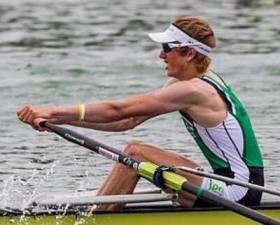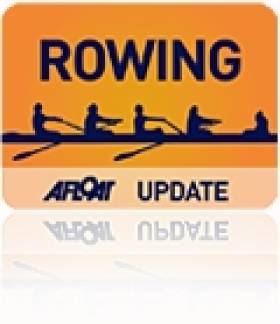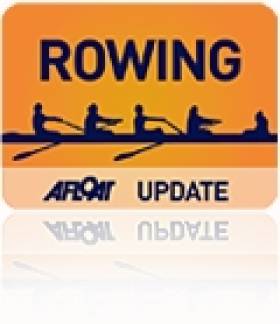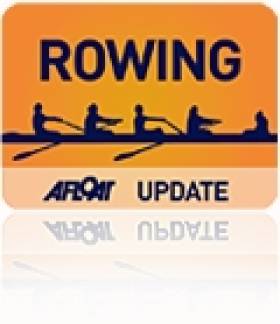Displaying items by tag: Ireland Trial
UCD Celebrate 100 Years in Style
#Rowing: The UCD Boat Club centenary dinner was a huge and successful occasion, with 425 attendees. Tom Sullivan (81) was the keynote speaker and gave a summation of the history of the club: not just the good days, such as the 1974 win in the Ladies Plate at Henley Royal Regatta (he was the coach), but also the tough times early on, when one of the mentors, James Meenan, said that “championships were not for the likes of us”.
Sullivan was not the only one who could look back to the middle of the last century and revel in the successes. Michael Cleary (91) rowed in the late 1940s and early 1950s. He received a special award.
Ten other presentations were made to important figures in the history of the club.
UCD Centenary Awards
Liz Cooke, Colm Daly, Johnny Devitt, Martin Feeley, Claire Lambe, David Neale, Murrough O’Brien, Jaye Renehan, Brian Sherry, Tom Sullivan.
Big Group Invited to Ireland Trial
Rowing: Thirty nine senior and under-23 competitors and 59 juniors have been invited to attend the Ireland trials on March 25th and 26th
Most competed at the recent Ireland trials, though David O’Malley, who could not attend, and the Spain-based Oisin and Dervla Forde have been asked to attend in March.
Invitees to Ireland Trial, March 25th and 26th:
Men – Single, Heavyweight: S McKeown T Oliver. Under-23: D Lynch, K Mannix, D Begley, R Byrne, D Buckley, E Whittle. Lightweight: P O’ Donovan, G O’ Donovan, C Beck, D O’Connor, N O’Reilly, A Burns, L Keane. Under-23: A Goff, C Hennessy, S O’Connor, N Beggan, M Taylor, J McCarthy, F McCarthy, S O’Connell.
Pair – Lightweight: S O’Driscoll, M O’Donovan. Under-23: D O’Malley, S Mulvaney.
Women – Single, Heavyweight: S Puspure, M Dukarska. Under-23: E Hegarty. Lightweight: D Walsh.
Pair – Heavyweight : A Keogh, A Feeley. Under-23: E Lambe, R Gilligan, T Hanlon, A Mason, D Forde, O Forde.
Juniors
Men – Sweep:
|
R Corrigan, A Johnston |
|
T McKeon, D O’Byrne |
|
C Garvey, B McKeon |
|
C MacRae, A Wilson |
|
J McKenna, S O’Donnell |
|
R Balcombe, C McLaughlin |
|
O O’ Toole, E Meehan |
|
N Twomey, O Donaghy |
|
M Lynch, E Jarvis Sculling: |
|
B O’Flynn |
|
J Keating |
|
O Clune |
|
J Quinlan |
|
T McKnight |
|
R Quinn |
|
E Curtin |
|
A O’Toole |
|
M Dundon - subject to fitness; |
|
A Christie |
|
E Gaffney |
|
A Byrne C O’Sullivan Women – Sweep Z McCutcheon, MJ Elliott E O’Reilly, G McGirr C Fee, M Kelly M Carmody, M Tully S Maxwell, A Keogh M Kovacs, C Minehane G MacNamara, K Dolan |
|
Sculling |
|
H Scott |
|
M Cremen |
|
A Casey |
|
C Nolan |
|
G O'Brien |
|
A O’Sullivan |
|
C Browne |
|
C Nic Donncha |
|
R Carson |
|
C Synnott - subject to fitness; |
|
C Moynihan |
|
S Burns A Keating E Crowley |
Ireland Trial in Doubt
#Rowing: The Ireland trial this weekend is in doubt. The National Assessment has been fixed for the National Rowing Centre at Farran Wood on Saturday and Sunday, December 19th and 20th, but the weather forecast is not good. Rowing Ireland has announced that a decision will be made on Wednesday. “The conditions at present do not look great. We are keeping a very close eye on the wind forecast as well as the amount of flood water coming into the lake.”
Paul O'Donovan is Afloat Rower of the Month
#Rower of the Month: The Afloat Rower of the Month for October is Paul O’Donovan. The UCD lightweight was quite outstanding at the Ireland trial. He was by far the fastest single sculler, setting a time of seven minutes 21.24 seconds in the heat and 7:22.63 in the final. Paul O’Donovan, in combination with his brother Gary O’Donovan, has been rightly feted for qualifying the Ireland lightweight double for the Olympic Games, and he has continued to set an exemplary standard.
Rower of the Month awards: The judging panel is made up of Liam Gorman, rowing correspondent of The Irish Times and David O'Brien, Editor of Afloat magazine. Monthly awards for achievements during the year will appear on afloat.ie and the overall national award will be presented to the person or crew who, in the judges' opinion, achieved the most notable results in, or made the most significant contribution to rowing during 2015. Keep a monthly eye on progress and watch our 2015 champions list grow.
#ROWING: Leonora Kennedy and Monika Dukarska will team up in a double scull for Ireland at the Memorial Paolo d’Aloja Regatta in Piediluco in Italy on April 10th to 12th. Lisa Dilleen, who partnered Kennedy in the pair last season, has been ill, and Helen Hannigan, who teamed up with Dukarska in the double, is recovering from injury. The lightweight men’s double of Gary and Paul O’Donovan and the lightweight women’s double of Claire Lambe and Denise Walsh, along with single sculler Sanita Puspure have also been given the nod after the second day of the final Ireland Trial at the National Rowing Centre in Cork. Siobhán McCrohan will compete in the lightweight single sculls.In Sunday's testing, the under-23 lightweight four were faster than the nominated senior lightweight four.
Ireland Final Trial: Selected Results (weighted for class of crew)
Saturday
Men
Fours, Double Sculls: 1 P O’Donovan, G O’Donovan (lightweight double) 6:59.0, 2 M O’Donovan, S O’Driscoll, M Bailey, A English (lightweight four) 6:57.30, Four (Coughlan) 6:56.52.
Lightweight Single Sculls: 1 F McCarthy 8:24.28, 2 A Burns 8:25.04, 3 S Toland 8:28.95.
Pararowing: T Kelly 6:09.01, 2 K Doherty 6:06.17.
Women
Doubles/Pairs: 1 D Walsh, C Lambe (lightweight double) 7:46.35, 2 M Dukarska, L Kennedy (pair) 8:00.26, 3 A Casey, E Hegarty (jun double) 8:17.29.
Single Sculls: 1 A Keogh 8:50.56. 2 O Finnegan 9:00.95, 3 B O’Brien (NUIG) 9:02.76.
Lightweight Single: 1 S McCrohan 8:44.47, 2 S Quinn 9:04.35.
Sunday
Fours, Quadruple Sculls, Double Sculls: 1 P O’Donovan, G O’Donovan (lightweight double) 6:41.34, 2 D O’Malley, L Seaman, S Mulvaney, L Keane (under-23 lightweight men’s four) 6:33.21, 3 S O’Driscoll, M Bailey, A English, M O’Donovan (lightweight men’s four) 6:37.49.
Pairs, Double Sculls, Single Sculls: 1 D Walsh, C Lambe (lightweight women’s double) 7:28.48, 2 M Dukarska, L Kennedy (heavyweight pair) 7:42.14, J Keohane (heavyweight single) 7:45.71.
Pairs, Single Sculls: 1 S Toland (lightweight) 7:44.72, 2 O’Connor, Carmody (lightweight pair) 7:19.94, McCarthy (lightweight) 7:46.63.
Double Sculls: 1 S McKeown, E Rowan (heavyweight double) 6:50.93, 2 P Doyle, M Rowan (heavyweight double) 7:04.43, 3 Munnelly, Byrne (heavyweight double) 7:10.56
Women’s Single Sculls: 1 S Puspure 7:59.07, 2 S McCrohan 8:21.93, 3 A Keogh 8:33.06.
Pararowing: 1 K Doherty 6:01.51, 2 T Kelly 6:12.62.
Lightweight Four Emerge from Ireland Trial
#ROWING: A lightweight men’s four of Shane O’Driscoll, Anthony English, Mark O’Donovan and Niall Kenny impressed the selectors at the Ireland trial at the National Rowing Centre sufficiently to become the nominated crew to train in advance of the final trial in March. Sinéad Jennings and Emma Desmond, who are both injured, were missing from the trial for the lightweight women’s double sculls. The matrix for the available candidates ranked Claire Lambe and Denise Walshe as the fastest crew. Paul and Gary O’Donovan are the nominated men’s lightweight double for the March Trials.
Ireland Trial, National Rowing Centre, Cork (Selected Results; ranked on per centage of projected World Championship gold medal winning time)
Men
Four, Under-23 Double and U-23 Lightweight Double: 1 E Rowan, S McKeown (heavyweight double) 7:11.86 (82.4), 2 Coughlan, Deere, Crowley Meehan (four) 6:46.77 (82.4), 3 F McCarthy, M Ryan (lm double) 7:27.35 (80.9).
Sculling and Lightweight Four: 1 G O’Donovan, P O’Donovan (lightweight double) 6:55.94 (87.0), 2 N Kenny, M O’Donovan, A English, S O’Driscoll (light four) 6:42.50 (84.5), 3 J Keohane, P Doyle (heavy double) 7:07.0 (83.2).
Single Sculls: 1 J Ryan (Lightweight) 7:49.42 (84.8 per cent), 2 S Toland 7:59.6 (lwt, 83.0) 3 M Rowan (heavyweight) 7:51.8 (82.7).
Women
Single/Double Sculls, heavyweight – Race One: 1 L Dilleen 8:03.21 (88.0), 2 L Kennedy 8:21.14 (84.8), 3 Dineen/O’Brien 8:06.17 (80.6). Race Two: 1 O Finnegan 8:41.3 (81.5), 2 A Keogh 8:49.40 (80.3), 3 O Forde 9:00.18 (78.7).
Lightweight Double Matrix: 1 D Walsh, C Lambe 7:36.38 (88.1), 2 S McCrohan, Sarah Dolan 7:43.12 (86.8), 3 R Morris, Sarah Dolan 7:56.55 (84.4).
Emma Desmond Takes Second Behind Jennings at Ireland Trial
#ROWING: Emma Desmond impressed at the Ireland trial at the National Rowing Centre today. The 28-year-old Corkwoman, who took up the sport in late 2012, finished second to Sinéad Jennings in the time trial for lightweight single scullers and took her place in the matrix for lightweight doubles with Jennings and Denise Walsh and Siobhán McCrohan, who finished third and fourth. Claire Lambe did not trial because of injury. The matrix later had to be abandoned when McCrohan pulled out injured.
Justin Ryan - a lightweight - was the fastest men's single sculler, with Dave Neale heading up the heavyweight ranks. Max Rowan, who is originally from Australia but now competes for Skibbereen, was second to Neale. Sanita Puspure, who has a rib injury could not compete in the women's single, with the pair of Lisa Dilleen and Leonora Kennedy and single sculler Monika Dukarska the fastest women. Paul O'Donovan and Gary O'Donovan trialled with this group as a lightweight double and set a good time.
Ireland Trial, Saturday, December 20th (Selected Results)
Heats (time trial over 19000m; per centage of projected world gold medal time)
Men
Heavyweight Pair: 1 Coughlan, Deere 6:44.29 (86.5 per cent), 2 Meehan, Crowley 6:48.38 (85.6), 3 Harrington, McGuckian (under-23) 6:51.06 (85.0).
Heavyweight Single: 1 D Neale 6:58.42 (88.5), 2 M Rowan 7:03.06 (87.6), 3 T Oliver 7:05.56 (87.1), 4 T Hughes 7:06.16 (86.9), 5 M Maher 7:06.94 (86.8), 6 E Rowan 7:07.6 (86.6).
Lightweight Single: 1 J Ryan 6:55.99 (90.9), 2 A Burns (under-23) 6:59.36 (90.2), 3 F McCarthy (u-23) 7:09.01 (88.1), 4 S Toland 7:09.34 (88.1).
Singles/Crew Boats (Men/Women): 1 P O'Donovan, G O'Donovan (lightweight men's double scull) 6:16.97 (91.2), 2 L Kennedy, L Dilleen (heavyweight women's pair) 7:01.34 (91.1), 3 M Dukarska (women's single) 7:27.39 (90.2), 4 K McCarthy (women's single) 7:40.32 (87.7), 5 S O'Brien (under-23 women's single) 7:55.6 (84.9).
Women
Lightweight Single: 1 S Jennings 7:23.67 (93.8 per cent), 2 E Desmond 7:29.96 (92.5), 3 D Walsh 7:31.27 (92.2), 4 S McCrohan 7:32.07 (92.0).
Ireland Trial Goes Ahead Despite Poor Weather Forecast
#ROWING: The Ireland trial will go ahead this Saturday at the National Rowing Centre in Cork, but the programme has been altered to take account of the forecast of poor weather. The organisers say there may be a window of opportunity early in the morning and have scheduled events around this possibility. If water assessment is ruled out the plan is to have a rate-capped ergo assessment.
Racing will consist of a time trial, which will give a ranking for a final. Heavyweight men’s pairs and lightweight men’s pairs will race together. Lightweight weigh in will be two hours before the race time of that event.
8am Briefing and number collection.
9am Lightweight men’s pairs/Heavyweight men’s pairs
9.05am Lightweight men’s singles
9.10 Heavyweight men’s singles
9.15 Lightweight women’s singles
9.20 Heavyweight women’s singles
Weather Threat to Ireland Rowing Trial
ROWING: The first Ireland trial, set for this weekend at the National Rowing Centre, has been restricted to this Saturday only because of concerns about the weather, and the event may yet have to be cancelled. The current plan is that competition will start at 9am with lightweight weigh in at 7am. Racing, if it is possible, will be in a time trial format with finals from 11:30am. There may be a chance that the water will be unsafe by then and if so, the time trial will be the only race and will give the ranking for the next set of trials. If the weather deteriorates further the trial may be cancelled. A final decision will be made tomorrow by 4pm tomorrow (Thursday).



































































